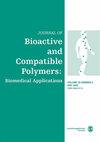Co-electrospun poly(vinyl alcohol)/poly(ɛ-caprolactone) nanofiber scaffolds containing coffee and Calendula officinalis extracts for wound healing applications
IF 2.1
4区 生物学
Q3 BIOTECHNOLOGY & APPLIED MICROBIOLOGY
引用次数: 5
Abstract
Fabrication of a biocompatible nanofibrous dressing with the advantage of the inclusion of bioactive herbal extracts is a promising approach in skin tissue engineering and wound healing applications. Herbal extracts possess many properties to promote the wound healing process, such as antioxidant properties, anti-inflammation activities as well as enhancing fibroblasts proliferation and migration. In this study, Calendula officinalis (C. officinalis) and coffee extracts were loaded into poly(vinyl alcohol)/poly(ɛ-caprolactone) (PVA/PCL) nanofibrous mats. The obtained scaffolds were then characterized using scanning electron microscopy (SEM), attenuated total reflection Fourier transform infrared (ATR-FTIR), contact angle, and mechanical measurements. Also, the antioxidant activity, scratch assay, and cell viability of fibroblast cells were also evaluated. The results showed PVA/PCL scaffold loaded with 10 wt% C. officinalis and coffee extracts displayed smooth homogenous morphology with 317 ± 106 nm average diameter. Moreover, the relevant analyses confirmed that the extracts were incorporated into the nanofibers with suitable hydrophilicity and higher mechanical strength (4 ± 0.4 MPa). The antioxidant assay showed that IC50 values of coffee and C. officinalis extracts were 46 ± 1 ppm and 101 ± 4 ppm, successively, which presented a high antioxidant activity. The combination of both extracts showed a higher rate of migration than individual extracts with not detected cytotoxic effects on the human dermal fibroblast cells. In conclusion, our results confirmed that the coffee and C. officinalis extracts loaded PVA/PCL nanofibrous scaffolds could provide an appropriate construct for wound healing applications.含有咖啡和金盏花提取物的共电纺丝聚(乙烯醇)/聚(β -己内酯)纳米纤维支架用于伤口愈合应用
生物相容性纳米纤维敷料的制备具有生物活性草药提取物的优点,在皮肤组织工程和伤口愈合应用中是一种很有前途的方法。草药提取物具有促进伤口愈合过程的许多特性,如抗氧化特性、抗炎症活性以及促进成纤维细胞的增殖和迁移。本研究将金盏菊和咖啡提取物分别装入聚乙烯醇/聚己内酯(PVA/PCL)纳米纤维垫中。然后使用扫描电镜(SEM)、衰减全反射傅立叶变换红外(ATR-FTIR)、接触角和力学测量对所得支架进行表征。同时对成纤维细胞的抗氧化活性、划痕实验和细胞活力进行了评价。结果表明,负载10 wt% officinalis和咖啡提取物的PVA/PCL支架形貌光滑均匀,平均直径为317±106 nm。此外,相关分析证实,提取物掺入纳米纤维具有良好的亲水性和较高的机械强度(4±0.4 MPa)。结果表明,咖啡提取物的IC50值分别为46±1 ppm和101±4 ppm,具有较高的抗氧化活性。两种提取物的组合显示出比单独提取物更高的迁移率,而未检测到对人真皮成纤维细胞的细胞毒性作用。综上所述,我们的研究结果证实了咖啡和officinalis提取物负载PVA/PCL纳米纤维支架可以为伤口愈合提供合适的结构。
本文章由计算机程序翻译,如有差异,请以英文原文为准。
求助全文
约1分钟内获得全文
求助全文
来源期刊

Journal of Bioactive and Compatible Polymers
工程技术-材料科学:生物材料
CiteScore
3.50
自引率
0.00%
发文量
27
审稿时长
2 months
期刊介绍:
The use and importance of biomedical polymers, especially in pharmacology, is growing rapidly. The Journal of Bioactive and Compatible Polymers is a fully peer-reviewed scholarly journal that provides biomedical polymer scientists and researchers with new information on important advances in this field. Examples of specific areas of interest to the journal include: polymeric drugs and drug design; polymeric functionalization and structures related to biological activity or compatibility; natural polymer modification to achieve specific biological activity or compatibility; enzyme modelling by polymers; membranes for biological use; liposome stabilization and cell modeling. This journal is a member of the Committee on Publication Ethics (COPE).
 求助内容:
求助内容: 应助结果提醒方式:
应助结果提醒方式:


